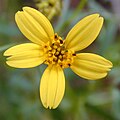Asteraceae
The family Asteraceae or Compositae (the aster, daisy, or sunflower family) is the largest family of flowering plants. It has the most species.
| Asteraceae | |
|---|---|

| |
| Scientific classification | |
| Kingdom: | |
| Division: | |
| Class: | |
| Order: | |
| Family: | Asteraceae |
What looks like its flower is really made of hundreds or thousands of tiny individual flowers. The technical term for it is a pseudanthium ("false flower").
The driving force for the evolution of the Asteraceae was that the composite flowers look attractive to pollinating insects. A large brightly coloured flower attracts insects. The other quality insects like is the scent of the pollen and the sugary nectar in the flowers. The asters are very successful (over 32,000 known species of flowering plants in over 1,900 genera in the order Asterales). Their success is due to what they offer to visiting insects. It is also due to their ability to grow almost anywhere, but especially on grass.[1][2]
Heterocarpy, or amphicarpy, the ability of an annual species to produce different fruit morphs, is common in Asteraceae. It allows seeds to be dispersed over varying distances, each type adapted to different environment. This increases the chances of survival.[3][4]
Asteraceae Media
A typical Asteraceae flower head showing the (five) individual ray florets and the (approximately 16) disk florets of a specimen of (Bidens torta)
Discoid flowerheads of Delairea odorata.
The twining succulent, Senecio angulatus, is used for its cut flowers, despite being an invasive weed in some places, such as Victoria, Australia and New Zealand.
Pseudogynoxys chenopodioides is used as an ornamental plant for its bright orange flowers.
References
- ↑ Judd W.S; Campbell C.S; Kellogg E.A.; Stevens P.F; Donaghue M.J. 2007. Plant systematics: a phylogenetic approach. 3rd ed, Sunderland: Sinauer Associates. ISBN 978-0878934072
- ↑ Funk V.A.; Susanna A.; Stuessy T.E.; Bayer R.J. (eds). Systematics, evolution and biogeography of Compositae. Vienna: International Association for Plant Taxonomy.
- ↑ Gardocki, Mary E.; Zablocki, Heather; El-Keblawy, Ali; Freeman, D. Carl 2000. Heterocarpy in Calendula micrantha (Asteraceae): the effects of competition and availability of water on the performance of offspring from different fruit morphs. Evolutionary Ecology Research. 2 (6): 701–718.
- ↑ Greenwood, Paul J; Harvey, Paul H; Slatkin, Montgomery 1985. Evolution: Essays in honour of John Maynard Smith. CUP Archive, p149. ISBN 9780521257343
| Wikispecies has information on: Asteraceae. |







